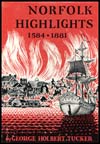Chapter 14
George Washington in Norfolk
George Washington visited the Norfolk area many times, but according to historical evidence he was in Norfolk proper on only two occassions. The initial visit was on May 25, 1763, when the thirty-one-year-old Washington was on his way to visit the Dismal Swamp for the first time. The second was on May 28-29, 1763, when he was on his way back to Mount Vernon.
Washington first passed through the Norfolk area late in 1751, when he sailed with Lawrence Washington, his half brother, out of the Virginia Capes for the Barbadoes. After returning by the same route a few months later, he was absent from the Norfolk area until 1763, when he became interested in the Dismal Swamp as a money-making proposition.
Washington, along with five others, had formed a company known as "Adventurers for the Draining of the Great Dismal Swamp." The company had acquired about forty thousand acres of rich timberland in the swamp, and Washington, as manager of the company, visited the swamp to gain firsthand information about it.
Leaving Mount Vernon on May 16, 1763, Washington set out for Williamsburg to attend an extra session of the House of Burgesses. On Wednesday, May 25, 1763, according to his carefully kept expense accounts, he set out on horseback down the Virginia Peninsula for Hampton, where he paid one shilling, five pence to be ferried over to Norfolk. Arriving there, Washington took another ferry to Portsmouth, paying one shilling, six pence for his fare, and proceeded to Colonel Edward Riddick's plantation in Nansemond County, from which he set out to explore the Great Dismal, which he described as "a glorious paradise."
On Saturday, May 28, 1763, he arrived at Great Bridge in Norfolk County, from where he rode into Norfolk and stayed overnight at a tavern kept by John Reinsburg, paying him one pound, seventeen shillings, and six pence for board, lodging, and horse hire. Tradition says that since Washington was in Norfolk on a Sunday, he attended Morning Prayer at the Borough Church, now St. Paul's Episcopal Church. But there is no contemporary evidence that he did so.
After taking a ferry for Hampton on Sunday, May 29, Washington rode back to Mount Vernon by way of Williamsburg.
Washington is known to have made at least five other visits to his lands in the Dismal Swamp, but there is no record that he ever passed through Norfolk again. Records indicate that he used Suffolk as a base from then on because of its closer proximity to the swamp. But when Washington wanted his Dismal Swamp holdings charted, he entrusted the survey to Gershom Nimmo (? -1764), the surveyor of Norfolk County, whose map, dated "Norfolk, 20 November 1763," has been preserved. This chart includes the earliest known map of Lake Drummond.
Two other Norfolk-area Washington associations deserve mention.
On September 18, 1781, a month before the British troops under Lord Cornwallis laid down their arms at Yorktown while the bands played "The World Turned Upside Down," Washington, accompanied by members of his staff and several French officers, dined and held a council of war with Admiral Compte Francois Joseph Paul de Grasse aboard his flagship, the Ville de Paris, off Cape Henry. When six-foot Washington came aboard and was hugged around the middle by De Grasse, a short, stocky man, and was addressed as "Mon petit general!" everyone laughed heartily, launching the conference on a merry note.
The other incident took place in Norfolk on February 22, 1800, two months after Washington's death. On that occasion, thousands of Norfolk-area citizens, wearing deep mourning, marched to dirgelike music behind an empty black coffin to what is now St. Paul's Episcopal Church for a solemn funeral service, minus the corpse, in memory of the recently departed Father of His Country.
Chapter
15
Streets Where History Walked
Norfolk Highlights 1584 - 1881

See the "Table of Contents" for links to every chapter in Norfolk Highlights 1584 - 1881 by George Holbert Tucker.
